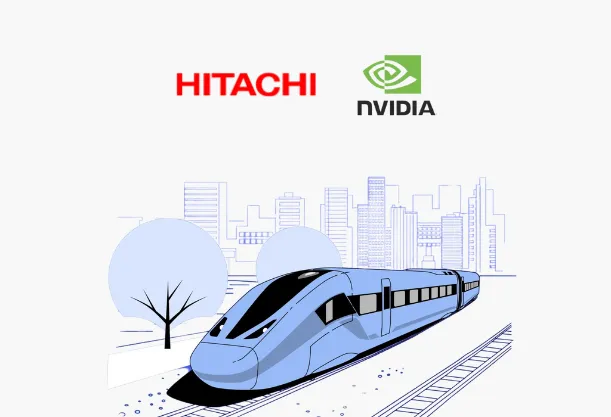
Hitachi’s AI-Powered Railway Maintenance System, Powered by Nvidia
In a significant step forward for the global rail industry, Hitachi Rail has unveiled an AI-powered railway maintenance service in partnership with Nvidia. This collaboration promises to transform how railway systems are maintained by utilizing advanced Artificial Intelligence (AI) technology, enabling more efficient, cost-effective, and safer railway operations.
AI-Powered Maintenance: What’s New?
The newly launched service, called HMAX (Hyper Mobility Asset Expert), is an all-in-one digital asset management platform designed specifically for railways. Traditionally, railway maintenance has relied heavily on periodic inspections, often resulting in costly delays and unforeseen repairs. HMAX, however, changes the game by integrating real-time data collection with AI-powered analytics, ensuring timely and accurate maintenance.
Why is This a Game Changer?
With the help of Nvidia’s IGX platform, the system collects data from sensors and cameras on trains, monitoring elements like heat, vibrations, and other key performance metrics. Instead of waiting for breakdowns to happen, AI continuously analyzes this data, predicting equipment failure before it occurs. This allows railway operators to address potential issues at the optimal time, minimizing disruptions.
Imagine this: trains essentially "talk" to the maintenance team, signaling the exact moment when parts need attention. It's like having a smart car, but for an entire railway system.
Key Features of the HMAX Platform
Let’s break down some of the key features of this innovative system:
1. Real-time Data Processing
HMAX leverages Nvidia’s Holoscan sensor processing platform to analyze massive amounts of data in real time, directly on the trains (also known as edge computing). This drastically reduces the time it takes to get actionable insights—previously, data analysis might have taken days, but now it happens almost instantly.
2. Predictive Maintenance
HMAX doesn't just monitor the current state of trains; it uses AI to predict future failures. By identifying potential issues early, operators can avoid costly last-minute repairs and minimize downtime. This also reduces repair costs by up to 15%, as unnecessary part replacements are avoided.
3. Remote Access and Control
The platform features a cloud-based architecture that allows railway operators to access maintenance data remotely. Whether they’re in the operational center or on-site, maintenance teams have the tools to monitor and respond to issues quickly.
Collaboration with Nvidia: Why it Matters
The partnership with Nvidia has been a critical factor in the success of this solution. Nvidia’s industrial-grade AI platform is designed specifically for high-performance applications like railway systems, offering the ability to handle vast amounts of data in real time. Nvidia’s cutting-edge GPUs (Graphics Processing Units) and sensor technologies provide the processing power needed to analyze the data collected by the trains at lightning speeds.
What Does This Mean for Railway Operators?
Railway operators now have the tools to streamline their operations with fewer breakdowns, faster repairs, and a safer rail network. In short, AI ensures that the railway system runs smoothly and efficiently, with fewer disruptions to passengers and lower operating costs.
Global Impact: Already in Use in the UK and Italy
While HMAX is being rolled out globally, it's already being used on some routes in the UK and Italy. These early implementations have demonstrated impressive results in improving railway safety and efficiency. As more countries adopt the technology, it's likely that HMAX will become a global standard for railway maintenance.
The Future of Rail Maintenance: AI is Here to Stay
In a world where AI is transforming industries, Hitachi’s partnership with Nvidia demonstrates just how impactful this technology can be. By applying AI to the operational side of railways, they’re setting a new standard for smart rail systems. We can expect further innovation in this space as railway companies around the globe embrace the power of AI to optimize performance, reduce costs, and ensure safety.
In conclusion, Hitachi Rail and Nvidia’s AI-powered maintenance service offers a bright future for railway operators and passengers alike. The combination of real-time data and predictive analytics will not only enhance the operational efficiency of rail networks but also push the boundaries of what’s possible in terms of safety and cost savings.
This collaboration marks the beginning of a digital transformation in railways that is poised to benefit millions of travelers worldwide.
FAQs
What is the HMAX platform?
HMAX is an AI-powered digital asset management platform by Hitachi Rail that optimizes the maintenance of railway systems using real-time data and predictive analytics.
How does HMAX help railway operators?
HMAX helps railway operators by predicting equipment failures, reducing downtime, and lowering maintenance costs by up to 15%.
What role does Nvidia play in this collaboration?
Nvidia provides the AI technology and processing power behind HMAX, enabling real-time data analysis directly on trains.
Where is HMAX currently being used?
HMAX is already being used on some railway routes in the UK and Italy.
How does this AI technology improve railway safety?
By predicting issues before they cause failures, AI helps maintain the railway system more efficiently, preventing accidents and enhancing overall safety.

 Prasanth Parameswaran
Prasanth Parameswaran
